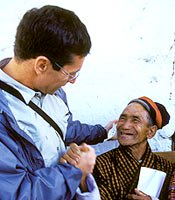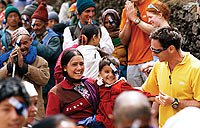Project empowers physicians in developing world to treat blindness
Himalayan Cataract Project trains surgeons to perform high-volume cataract surgery.

Scaling the tallest mountain was the starting point of an ophthalmic outreach project that has contributed to curing preventable blindness around the world.
|
|
Geoffrey Tabin, MD, co-founded a nonprofit organization after climbing Mount Everest and taking part in other mountaineering expeditions in Nepal. He began the Himalayan Cataract Project in 1995 with Nepali ophthalmologist Sanduk Ruit, MD. They originally started the group to cure preventable blindness from cataracts in the Himalayan countries of Nepal, Tibet and Bhutan, places that had some of the highest rates of curable blindness in the world.
They have since expanded the project to treating other eye conditions and into other developing countries. Recently, the project started an eye care intervention in North Korea and has outreach programs in India, Pakistan, Cambodia, Myanmar and China and is working in Africa as part of the U.N. Millennium Villages Project, according to Dr. Tabin.
He said the Himalayan Cataract Project is seeking to meet the world’s overwhelming need for surgeons to treat preventable blindness and to provide affordable health care for all patients. According to the World Health Organization, almost half of blindness cases are because of cataracts. There are nearly 18 million people in the world who are bilaterally blind from cataracts, the majority of whom live in developing nations.
In Nepal alone, more than 70% of blindness can be attributed to cataracts and failed cataract surgery. Because of the mountainous terrain, blindness causes immobility and often reduces life expectancy by nearly half for residents there, according to the project.
When Dr. Tabin first went mountaineering in Nepal, he said he was unsure of his medical specialty, but when he saw how the “miracle of cataract surgery” changed the lives of people there, he knew he wanted to enter ophthalmology. Working with Dr. Ruit, who brought the innovation of lens implantation surgery to that part of the developing world, sealed his desire to work in the field, he said.
“In the village where I was working, it was an accepted thing: People there got old, their hair turned white, their eyes turned white, and they died,” Dr. Tabin said in a telephone interview with Ocular Surgery News. “People would get depressed and basically wait to die. I saw a Dutch team come in and do cataract surgery with lens implants, and it just absolutely blew my mind, the miracle of bringing people not just sight, but back to life.”
How it works
|
Image: Amendolia M |
In its effort to help eliminate preventable blindness, the Himalayan Cataract Project trains local physicians in a skill-transfer educational program and sets up primary eye clinics for patients to receive treatment. The project educates physicians about high-volume cataract, corneal and retinal surgeries, and oculoplastic, pediatric and glaucoma subspecialties, Dr. Tabin said.
“Our whole focus is on educating and empowering local people to do the work,” he said.
After having a team of eye care specialists come to Nepal for training – surgeon, nurse and technician – they return to their home region and pre-screen a large number of residents for cataracts. Then physicians from Himalayan Cataract Project travel to that area. The newly trained surgeons observe while project surgeons perform cataract surgery in those patients’ first eyes; then, the local doctors operate on the patients’ second eyes, according to Dr. Tabin.
“In the skill-transfer training camp, we will often have the training doctor do 150 surgeries, more than most American residents do, and they become quite competent,” he said. “Then they still have a large number of people who are bilaterally blind or have had sight restored to the first eye that they can keep practicing on, so they can keep getting better.”
The project has courses that train not only physicians but also the entire ophthalmic team: surgeon, nurse and assistant. The project places an emphasis on educating ophthalmic assistants to act as ocular medical professionals in rural areas, prescribing glasses and screening for primary disease, he said.
In Nepal, assistants receive education from a 3-year training program in conjunction with Katmandu University, Dr. Tabin said. After receiving education, ophthalmic assistants are posted at rural primary care eye centers, where all residents receive screenings for serious eye conditions.
“[Assistants] do a lot of the support for doctors, but they also do primary care ophthalmology in a remote region, where we wouldn’t be stationing a doctor,” Dr. Tabin said.
Not only does the project train physicians in safe, high-volume surgery, but it also assists all patients in receiving medical care, he said. The project has a cost-recovery system that allows patients who cannot pay for medical care to receive it. About 65% of the project’s work is free care, with the remainder of patients who can pay partial or full costs for their medical care supporting the other procedures.
Exchange program
|
Image: Kvale A |
The project works in conjunction with other organizations and groups, including The Fred Hollows Foundation in Australia, the Aravind Eye Hospitals in India and the John A. Moran Eye Center, at the University of Utah, where Dr. Tabin teaches. Residents from Utah participate in outreach work in Nepal, India and other countries at the end of their training, while senior residents from Nepal and other countries spend 1 month learning in Utah, as part of the skill-transfer program, Dr. Tabin said.
“I think it’s really been an invaluable experience for them, and if just a few of my former students and fellows are making international eye care a big part of their career, which is the goal of sending residents over, it will make an enormous difference,” he said.
The Himalayan Cataract Project has been largely successful in its mission of training physicians in developing nations who want to treat patients in their home country, Dr. Tabin said. Throughout the years, he has watched the impact that a single ophthalmologist can have on a developing community.
Running the project has not always been easy, with the seemingly insurmountable blindness statistics, but it has been the highlight of his career as an ophthalmologist, he said.
“Every day is a new challenge in figuring out how to do things,” Dr. Tabin said. “The idea that we can overcome preventable and treatable blindness in our lifetime is a great quest to keep flailing after, and it keeps me excited and motivated for every day.”
Past, present and future
The project has been receiving attention in recent years from the media for its work, according to Dr. Tabin. National Geographic has featured the group in two television programs. Time magazine has highlighted the organization, and a recent documentary by filmmaker Michael Brown, Light of the Himalaya, has shown Dr. Tabin and others at work.
When Dr. Tabin first established the Himalayan Cataract Project with Dr. Ruit, he said there was a severe backlog of about 300,000 blind patients in mountainous regions of Asia, with about 80,000 new cases a year. In 1994, only 15,000 cataracts surgeries were performed in Nepal, 1,000 of which were IOL implantations – most of which were performed by Dr. Ruit, Dr. Tabin said.
In contrast, last year, more than 170,000 cataract surgeries were performed in Nepal, mostly all with IOL implantation. Dr. Tabin said the future of the Himalayan Cataract Project in the Himalayas will most likely be in specialty medicine because of the excellent training and groundwork that has been done there. He recently returned from a 3-week excursion to Nepal, but he said he is traveling to that country less often and Africa more often.
“Fortunately or unfortunately, I’ve made myself obsolete,” Dr. Tabin said. “Not only is the cataract surgery performed superbly in Nepal – Dr. Ruit is an amazing innovator in cataract surgery and we have just phenomenal young cataract surgeons – but even in corneal surgery, they’re doing such high volume and so many of them are so good, I’m just about obsolete. So I am focusing more of my time and energy in Africa, which is still far behind the state of what we have developed in Nepal.”
|
For more information:
- Geoffrey Tabin, MD, can be reached at the John A. Moran Eye Center, University of Utah, 65 N. Medical Drive, Salt Lake City, UT 80312; 801-581-2352; e-mail: gtabin@cureblindness.org; Web site: www.cureblindness.org.
- Erin L. Boyle is an OSN Staff Writer who covers all aspects of ophthalmology.



